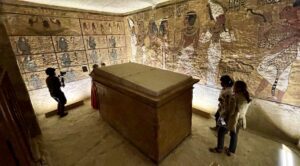
Luxor, Egypt — Before Howard Carter and his team of Egyptian workers made one of the greatest discoveries of all time on November 4th, 1922, Carter lived in a dig house atop a hill, surrounded by desert, only a short donkey ride away from the Valley of the Kings. The home’s construction was funded by his fellow archaeologist and photographer friend and financier Lord Carnarvon. Carter lived there from 1910-1939. Later, in the 1950’s it became a rest house for antiquities inspectors and in 2009 it was converted into a house museum to honor Howard Carter’s contributions to the field of archaeology.
_____________________________

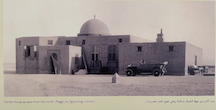
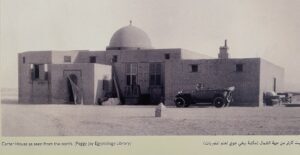
_____________________________
 The Restored House
The Restored House
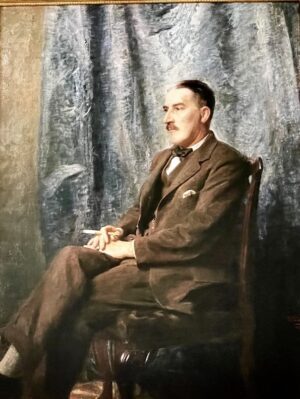
Portrait of Howard Carter. By William Carter. Public Domain.
The mudbrick of the home was in danger of collapse due to insufficient drainage. That pressing problem has since been corrected with a new drainage system to address rising water levels. A complete and thoughtful restoration of the home’s simple yet beautiful interior spaces was unveiled as well. The home is an elegant and peaceful space surrounded by lush greenery effectively transporting you back to Carter’s time. Director Nicholas Warner and Egyptologist Tom Hardwick worked with a team of restorers to match the colors of the walls and interior furnishings faithful to the period in which Carter lived in the house. The seemingly personal items displayed behind glass were historically accurate objects that an archaeologist would have used on a daily basis working in Egypt in the 1920’s. There are also replicas of Carter’s masterfully painted watercolor images throughout the home. (Carter’s father was a well-respected painter of landscapes and hunting scenes, and he followed in his father’s footsteps before becoming an archaeologist). The only personal item owned by Carter still on site is a foundation brick gifted to him by Lord Carnarvon to commemorate the foundation of the home.
_____________________________
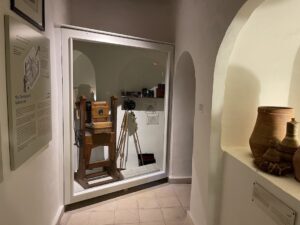
Above and below: Views of two of the rooms in the restored Carter House.
_____________________________
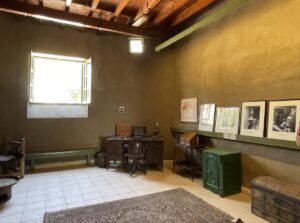
_____________________________
A Replicated Tomb and the Wonders of Digital Restoration
Steps away from the Carter house and on the same property was another re-opening: an exact and completed replica of King Tutankhamun’s tomb, created to ease the damaging effects of thousands of humans breathing moisture into the original tomb and endangering its delicate murals. Factum Arte in conjunction with the Theban Necropolis Preservation Initiative (TNPI) recreated the famous tomb by capturing an unbelievable 100 million measured points per square meter, 2.54 pixels/inch using a close-range, non-contact laser recording system called the Lucida 3D scanner, requiring 6 hours recording time per square meter. The technology was created in-house by artist-engineer Manuel Franquelo with a team of conservators and engineers. (The National Gallery in London recently acquired Factum Arte’s Lucida 3D scanner to record and digitize their collections).
_____________________________
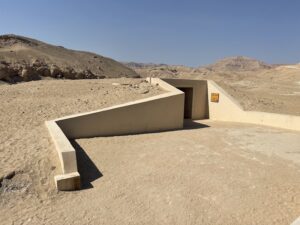
Exterior view of the replicated tomb of Tutankhamun.
_____________________________
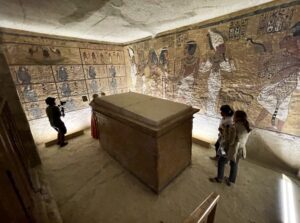
Interior view of the replicated tomb of Tutankhamun.
_____________________________
The only thing missing in this replica tomb is the mummy of the boy king. One item not in the original tomb but included in the replica tomb is a recreation of the painted plaster wall painting that was created by the ancient artists to hide the burial chamber on the other side from tomb robbers. The scene shows the goddess Isis greeting Tutankhamun with her hands down, palms up in a welcoming nini gesture conveyed by two hieroglyphs held in her hands. Three underworld deities are shown seated behind the goddess. The original fragments of this sacred scene were unfortunately lost to time after Howard Carter broke through the wall to access the burial chamber. The pieces were reconstructed utilizing Harry Burton’s original photographs from 1922 and Factum’s cutting-edge 3D photo technology.
____________________________
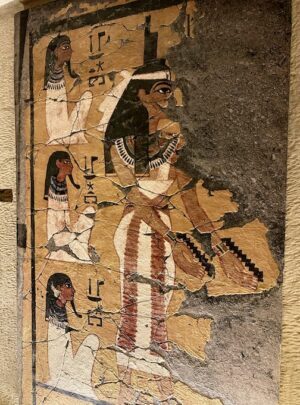
The recreated wall painting lost by Carter.
____________________________
Director and visionary Egyptologist Aliaa Ismail explains, beaming with pride “The level of details this technology can record far surpasses anything the naked eye can capture.” For example, when Factum worked on scanning the alabaster sarcophagus of Seti I housed at Sir John Soane’s museum in London through their high-resolution scans, technicians were able to bring to light the complex carved sarcophagus hieroglyphs, otherwise invisible today due to thousands of years that have damaged the original paint. They were also able to piece together the remaining fragments of the sarcophagus lid to eventually create a 3D replica of the complete sarcophagus.
____________________________
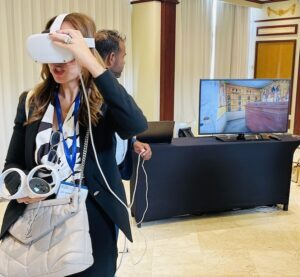
Virtual reality experiences will become common as an aid to helping the public understand our ancient heritage.
____________________________
Digital restoration is fast becoming a vital tool for restorers and is changing the way academia functions. In their recently completed Seti I project, Florence Baberio and the team from Basel University pieced together many fragments using this new technology. They recorded fragments from the Boston Museum of Fine Arts, the Louvre in Paris, the Ägyptisches Museum und Papyrussammlung in Berlin, the British Museum, Sir John Soane’s Museum in London, the Griffith Institute in Oxford, the Archaeological Museums in Bologna and Florence and in a private collection. All these recorded fragments will be reconstructed virtually and archived into Factum Foundation’s final facsimile, resulting in a copy which will be more complete than the original tomb as it stands today.
___________________________
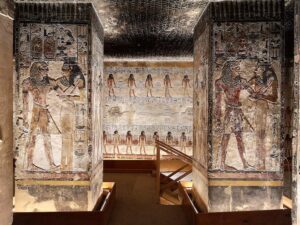
The tomb of Seti I. Carole Raddato, Creative Commons Attribution-Share Alike 2.0 Generic, Wikimedia Commons
___________________________
Ismail explains that the data recorded for the Seti I tomb allowed them to complete another exact replica of the Hall of Beauties from inside Seti’s tomb and they are currently negotiating with the Grand Egyptian Museum (GEM) to have it included as a permanent addition to the museum’s collection, providing a more immersive experience for visitors. Factum Arte’s next project is to fully document Queen Nefertari’s tomb and to eventually train many teams, preferably Egyptians, so they can scan all the remaining tombs in the Theban Necropolis, numbering over 1,500.
The readily available photographic data will also allow for researchers to easily reunite artifacts or plaster fragments from different museums or private collections across the world, enabling researchers to finally fill in the blanks. In essence, it is a new tool to add to the arsenal that archaeologists can use to recreate the past and make exciting new discoveries.
One example of a potential discovery utilizing this non-invasive technology occurred in 2009. Britisha rchaeologist Nicholas Reeves reviewed high resolution scans of the burial chamber walls and noticed in the relief renderings presented in separate layers that there were slight variations in that wall. This information was crucial for Reeves to formulate the theory he presented recently at the ARCE Centennial Event in Luxor. Through studying this forensic data and differences behind painted cartouches on the burial chamber’s walls, he theorizes that Nefertiti’s tomb may be hidden behind that wall in the same way Tutankhamun’s burial chamber was hidden behind a decorated false wall.The potential for finding another intact tomb on par with Tutankhamun’s is a possibility that has captured the imagination of millions around the globe.
If the people cannot be brought to these works of ancient art, then Factum intends to bring these monuments to the people and at the same time preserve them in perpetuity because, at any moment a natural disaster such as an earthquake or flood can destroy these ever-important monuments to humanity in an instant. A recent article from the New York Times highlights work done to combat the effects of climate change already damaging sites across Egypt.
Factum Arte is a pioneer in marrying VR technology with archaeology to protect sites like King Tutankhamun’s tomb, to promote archaeology to children in schools, and inspire us all to look more closely at these ancient sites left behind by our ancestors. They are close to launching the VR experience of King Tutankhamun’s tomb. The potential for education and generating interest is limitless.
A report on Factum’s work completed thus far in the Tomb of Seti I in conjunction with the University of Basel and Egypt’s Ministry of Tourism & Antiquities is here. You can also visit the reconstructed tomb (sarcophagus included) of Seti I at the Valley of the Kings virtually here.
Another pioneering company using VR technology to inspire future generations in the field of archaeology is Positron, an American company. They recently created a mind-blowing 4D, virtual reality experience for the Ramses the Great exhibit, currently on nationwide tour and available to experience at San Francisco’s de Young Museum.
Any lover of our ancient past has dreamt of teleporting in a time machine to see how it all really looked and felt. Positron is like that time machine, enabling us to see and feel what it was like and will only be more immersive as the technology improves over time.
It isn’t hard to imagine museums around the world incorporating these new technologies to inspire generations of archaeologists and enthusiasts of our ancient past well into the future.
Advertisement
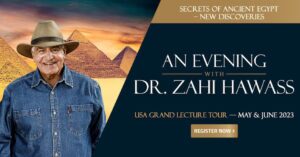
Don’t miss out on this unforgettable evening as Dr. Hawass reveals the most closely guarded secrets of ancient Egypt and presents his groundbreaking new discoveries and latest research live on stage. As the man behind all major discoveries in Egypt over the last few decades and director of several ongoing archaeological projects, Dr. Hawass may yet surprise you with unexpected revelations that will make news across the world.
_____________________________


